Instruction
A popular short-game tip could be hurting your game
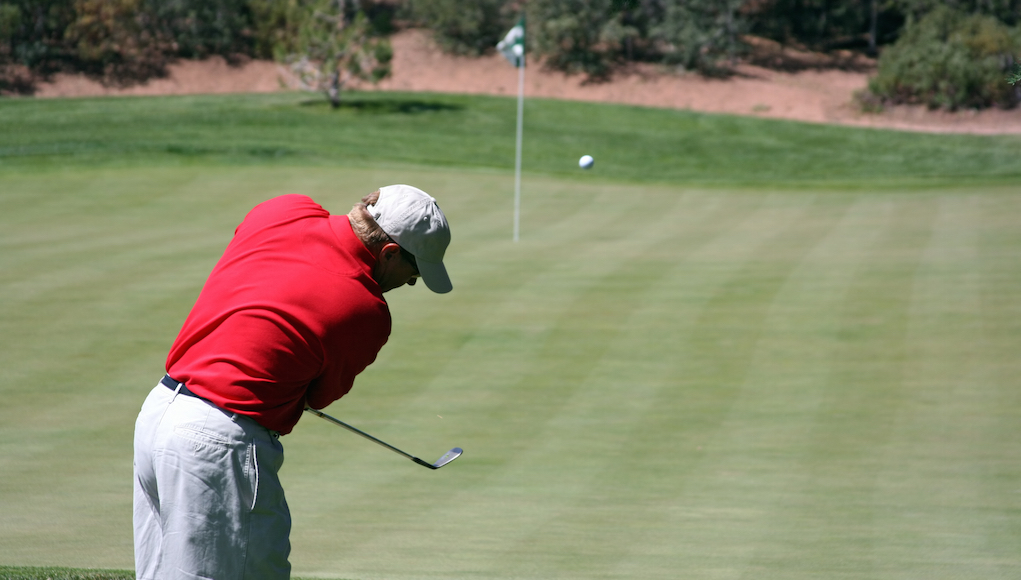
Not too long ago, a prominent LPGA Player was up at our facility, working on her golf game. She’s around enough throughout the year that I feel comfortable saying hello, asking her how she’s playing, and sharing some insignificant social pleasantries. The golf course is her office and I always want to respect the time and energy she puts into her golf game. This day, however, she was in the mood for competition. And of course, I was up for it. I had enough time for some closest-to-the-pin contests before I needed to meet my next student.
While I did my best to be competitive and not “throw up all over myself,” I was studying her skill set with great interest. One characteristic about her technique truly surprised me, though. This player, who has competed in multiple Solheim Cups and was an LPGA Tour winner with roughly $5 million in tour earnings, was transferring her weight for all of her short-game shots. It didn’t matter if it was a simple chip, a longer pitch over a bunker or a flop shot; her weight was moving back and forward. This, of course, got me thinking. Why would a world-class player use this technique for her short game? My research has led to the following conclusion: Many golfers have a tendency to overlearn skill sets, especially with their short game.
With ball contact being the first characteristic to a good shot, players put more weight/pressure on their lead foot at setup in an effort to move the bottom of their swing arc forward. The problem with exaggerating that setup, however, is that it can cause golfers to struggle with the following issues.
The delivery of the golf club can be too descending. Much of golf lore encourages 75-90 percent of our weight or pressure be on our lead leg at impact. That works wonderfully for a full swing, when there is plenty of club head speed to move through the turf after impact and not get stopped. On short-game shots with less club head speed, however, this much pressure on the lead leg at impact can expose the leading edge of the club too much and can create inconsistent ball contact and turf interaction.
Balance can suffer. You’ve heard me say this many times. Balance is the third most subconscious condition of your body. If a golfer has too much weight on the lead foot, he/she may need to frequently move up or backward to stay in balance during the motion, especially during the downswing. This can change the bottom of the swing arc and produce inconsistent contact.
Data from my BodiTrak system, as well as video, shows how too much pressure on the lead foot can result in a counter-balancing motion that produces a less consistent delivery of the golf club into impact. I’ve also found that there are benefits to having a transfer of pressure for your short-game shots. If the skill set for short-game shots and full-swing shots remains similar, it means that golfers have one less skill set to practice for their already limited practice sessions.
Please Note: In the images below, the orientation of the golfer’s feet shown in the BodiTrak graphic (top of image) are the opposite of the golfer’s feet on the BodiTrak mat. So the golfer’s left foot in the BodiTrak image is on the left side, and on the right side of the BodiTrak mat.
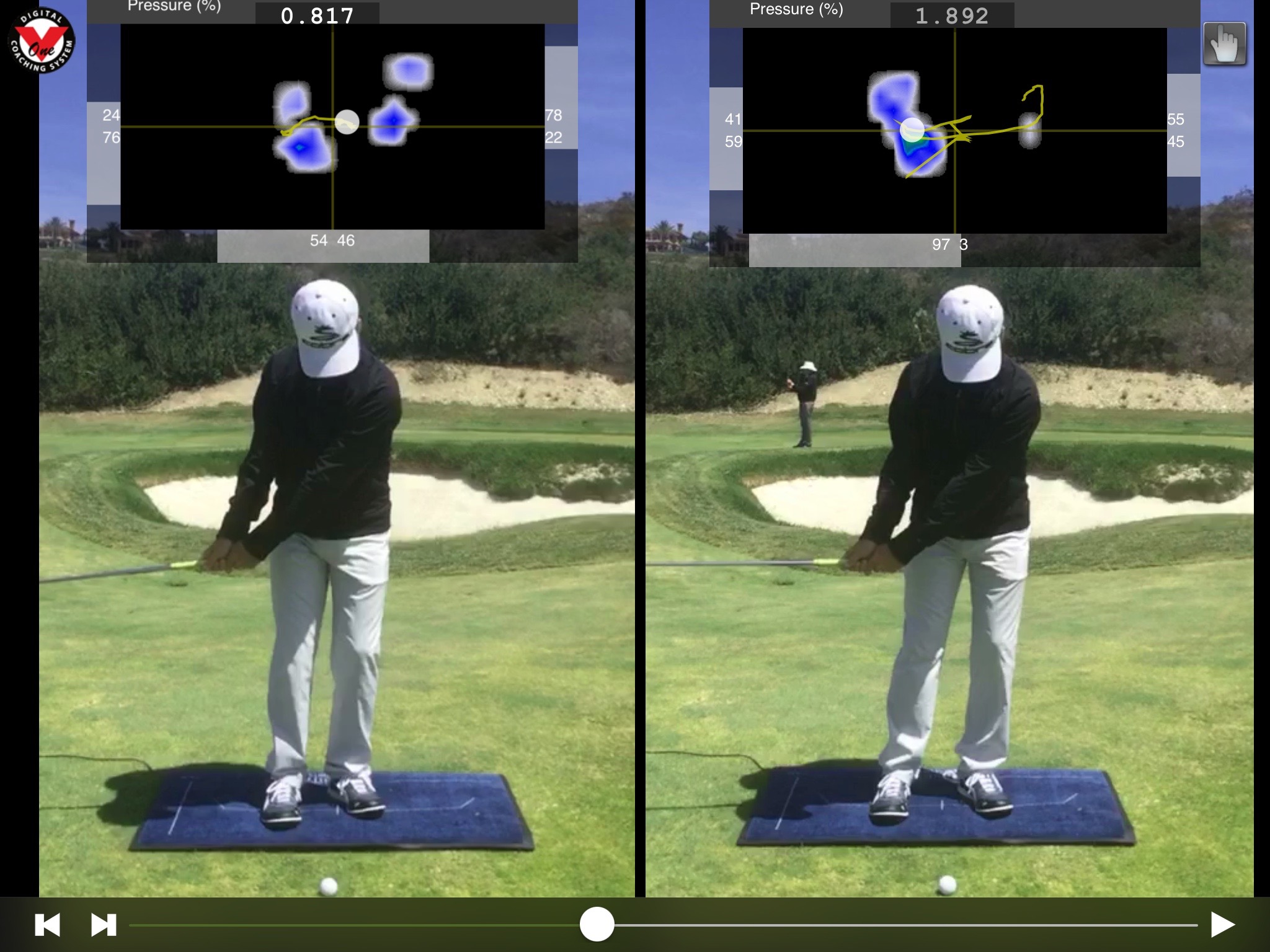
At the top of the backswing, the (L) golfer has made a small transfer of pressure toward the trail foot. The (R) golfer has moved more pressure to the lead foot.

Both golfers have 80 percent of their pressure on the lead foot, 20 percent on their trail foot, but they arrived there in different ways and at different times.

Here is the same photo as above. The (L) golfer is moving forward laterally, shown with the + Lateral # in the white box in the right hand corner.

The (L) golfer has more forward pressure at impact, but his pressure has barely changed compared to when it was at 80/20 and his club head was 3 feet from impact. This means stability.

The (R) golfer continues to be unstable with his foot work. It’s hard to hit the golf ball solidly with this connection to the ground.
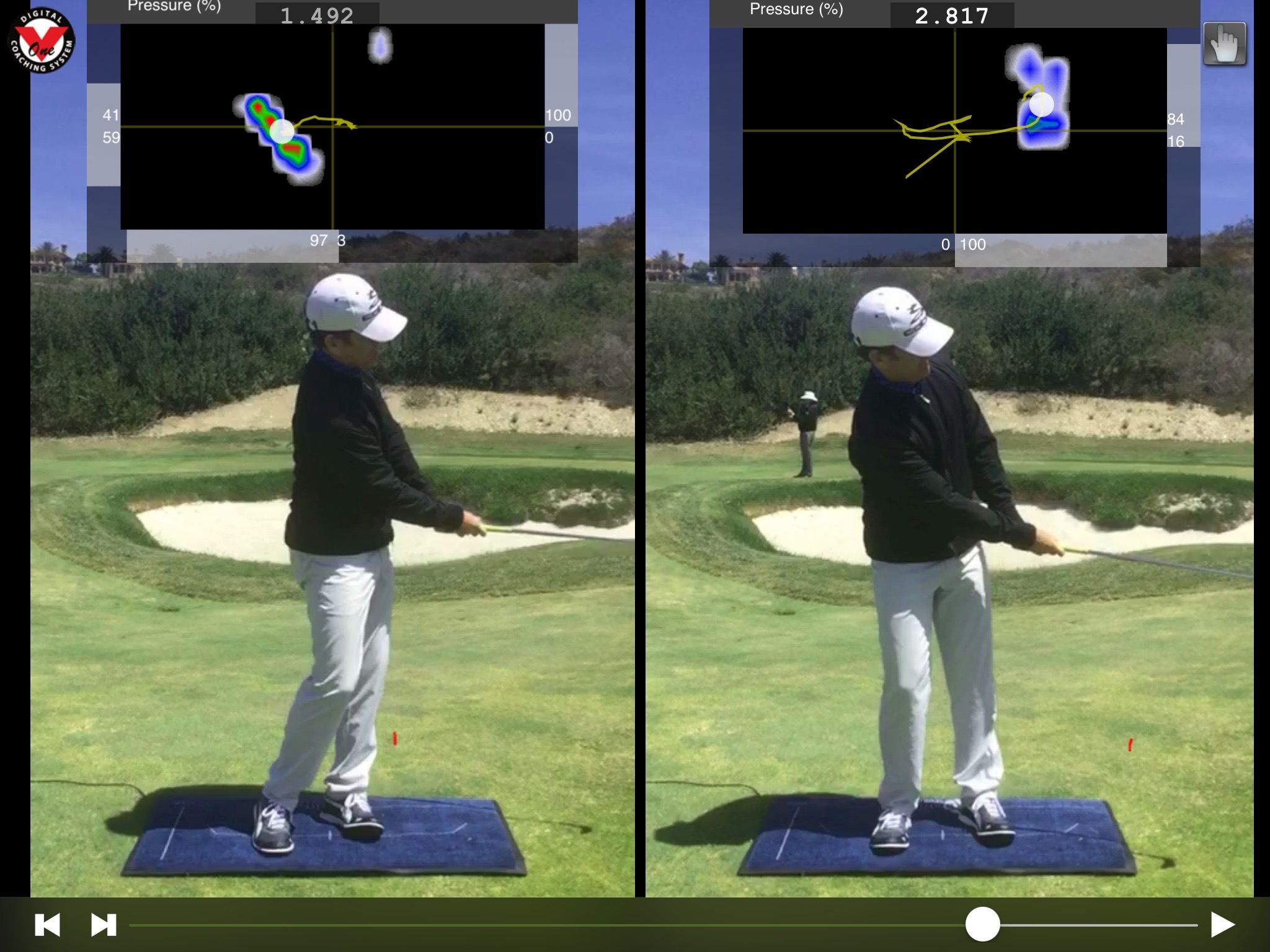
The (R) golfer has gone from 97 percent pressure to the lead foot at the top of the motion to 100 percent pressure on the trail foot in less than 1 second. Can you say unstable?
Let’s say you like what you’re hearing and decide to try transferring your weight forward on short-game shots. Because your pressure and mass are moving forward, you can release the golf club sooner and become more proficient at using the bounce of the club. Research is showing that more short-game shots need less shaft lean at impact, not more. So by moving your weight forward, low spinners, stock pitches and flop shots are frequently more easy to execute. So how can golfers practice this technique and delivery of the golf club? Use this simple step drill.
- Take your regular stance for your short-game shot.
- Before you start your backswing, move your lead foot so that it is almost touching your trail foot. Begin your backswing by moving the club from there.
- Before you complete your backswing, replant your lead foot to the position it’s normally in when you take your regular address position.
- Do this while trying to deliver your golf club so that the bounce of your club interacts with the turf during the stroke.
While this drill sounds very different and perhaps difficult, I recommend you give it a go, especially if you suffer from the symptoms described above. You may be surprised how quickly you get the hang of it, and it just might make you more comfortable with short-game shots. It can help you deliver the golf club with less shaft lean, and many golfers find that they become more proficient with a softer interaction between golf ball and club head.
Of course, I don’t want you to take this step drill onto the course. Once you get comfortable with it, try to copy the feeling of the weight shift without taking the step. Good Luck!
- LIKE93
- LEGIT23
- WOW4
- LOL3
- IDHT2
- FLOP3
- OB1
- SHANK59
Instruction
Clement: Laid-off or perfect fade? Across-the-line or perfect draw?

Some call the image on the left laid off, but if you are hitting a fade, this could be a perfect backswing for it! Same for across the line for a draw! Stop racking your brain with perceived mistakes and simply match backswing to shot shape!
- LIKE1
- LEGIT0
- WOW0
- LOL0
- IDHT0
- FLOP0
- OB0
- SHANK1
Instruction
The Wedge Guy: The easiest-to-learn golf basic

My golf learning began with this simple fact – if you don’t have a fundamentally sound hold on the golf club, it is practically impossible for your body to execute a fundamentally sound golf swing. I’m still a big believer that the golf swing is much easier to execute if you begin with the proper hold on the club.
As you might imagine, I come into contact with hundreds of golfers of all skill levels. And it is very rare to see a good player with a bad hold on the golf club. There are some exceptions, for sure, but they are very few and very far between, and they typically have beat so many balls with their poor grip that they’ve found a way to work around it.
The reality of biophysics is that the body moves only in certain ways – and the particulars of the way you hold the golf club can totally prevent a sound swing motion that allows the club to release properly through the impact zone. The wonderful thing is that anyone can learn how to put a fundamentally sound hold on the golf club, and you can practice it anywhere your hands are not otherwise engaged, like watching TV or just sitting and relaxing.
Whether you prefer an overlap, interlock or full-finger (not baseball!) grip on the club, the same fundamentals apply. Here are the major grip faults I see most often, in the order of the frequency:
Mis-aligned hands
By this I mean that the palms of the two hands are not parallel to each other. Too many golfers have a weak left hand and strong right, or vice versa. The easiest way to learn how to hold the club with your palms aligned properly is to grip a plain wooden ruler or yardstick. It forces the hands to align properly and shows you how that feels. If you grip and re-grip a yardstick several times, then grip a club, you’ll see that the learning curve is almost immediate.
The position of the grip in the upper/left hand
I also observe many golfers who have the butt of the grip too far into the heel pad of the upper hand (the left hand for right-handed players). It’s amazing how much easier it is to release the club through the ball if even 1/4-1/2″ of the butt is beyond the left heel pad. Try this yourself to see what I mean. Swing the club freely with just your left hand and notice the difference in its release from when you hold it at the end of the grip, versus gripping down even a half inch.
To help you really understand how this works, go to the range and hit shots with your five-iron gripped down a full inch to make the club the same length as your seven-iron. You will probably see an amazing shot shape difference, and likely not see as much distance loss as you would expect.
Too much lower (right) hand on the club
It seems like almost all golfers of 8-10 handicap or higher have the club too far into the palm of the lower hand, because that feels “good” if you are trying to control the path of the clubhead to the ball. But the golf swing is not an effort to hit at the ball – it is a swing of the club. The proper hold on the club has the grip underneath the pad at the base of the fingers. This will likely feel “weak” to you — like you cannot control the club like that. EXACTLY. You should not be trying to control the club with your lower/master hand.
Gripping too tightly
Nearly all golfers hold the club too tightly, which tenses up the forearms and prevents a proper release of the club through impact. In order for the club to move back and through properly, you must feel that the club is controlled by the last three fingers of the upper hand, and the middle two fingers of the lower hand. If you engage your thumbs and forefingers in “holding” the club, the result will almost always be a grip that is too tight. Try this for yourself. Hold the club in your upper hand only, and squeeze firmly with just the last three fingers, with the forefinger and thumb off the club entirely. You have good control, but your forearms are not tense. Then begin to squeeze down with your thumb and forefinger and observe the tensing of the entire forearm. This is the way we are made, so the key to preventing tenseness in the arms is to hold the club very lightly with the “pinchers” — the thumbs and forefingers.
So, those are what I believe are the four fundamentals of a good grip. Anyone can learn them in their home or office very quickly. There is no easier way to improve your ball striking consistency and add distance than giving more attention to the way you hold the golf club.
More from the Wedge Guy
- The Wedge Guy: Golf mastery begins with your wedge game
- The Wedge Guy: Why golf is 20 times harder than brain surgery
- The Wedge Guy: Musings on the golf ball rollback
- LIKE88
- LEGIT15
- WOW6
- LOL1
- IDHT0
- FLOP4
- OB1
- SHANK9
Instruction
Clement: Stop ripping off your swing with this drill!

Not the dreaded headcover under the armpit drill! As if your body is defective and can’t function by itself! Have you seen how incredible the human machine is with all the incredible feats of agility all kinds of athletes are accomplishing? You think your body is so defective (the good Lord is laughing his head off at you) that it needs a headcover tucked under the armpit so you can swing like T-Rex?
- LIKE0
- LEGIT3
- WOW2
- LOL0
- IDHT0
- FLOP0
- OB0
- SHANK2
-

 19th Hole3 weeks ago
19th Hole3 weeks agoLET pro gives detailed financial breakdown of first week on tour…and the net result may shock you
-

 19th Hole1 week ago
19th Hole1 week agoReport: LIV star turns down PGA Championship invite due to ‘personal commitments’
-

 19th Hole2 weeks ago
19th Hole2 weeks agoGary Player claims this is what ‘completely ruined’ Tiger Woods’ career
-

 Equipment1 week ago
Equipment1 week agoDetails on Justin Thomas’ driver switch at the Wells Fargo Championship
-

 Whats in the Bag3 weeks ago
Whats in the Bag3 weeks agoTeam McIlowry (Rory McIlroy, Shane Lowry) winning WITBs: 2024 Zurich Classic
-

 Whats in the Bag1 week ago
Whats in the Bag1 week agoKeegan Bradley WITB 2024 (May)
-

 Equipment2 weeks ago
Equipment2 weeks agoGolf fans left surprised by LIV’s choice of course for its 2024 individual championship event
-

 Whats in the Bag4 days ago
Whats in the Bag4 days agoRory McIlroy’s winning WITB: 2024 Wells Fargo Championship














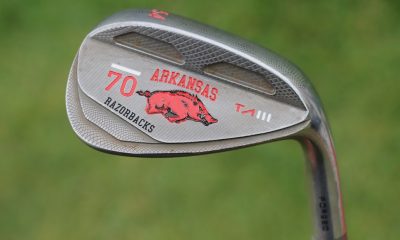

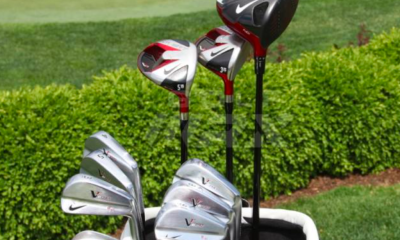





Lee
May 11, 2016 at 1:53 pm
Just be like Phil. Hinge & Hold. Done deal. “Secrets of the Short Game”
Ike
May 11, 2016 at 10:40 am
The author and all commentators have missed the most important setup point in this discussion – that being the proper orientation of the feet in a short shot. Had a student just this week who WAS prone to sha##ing his short club shots. He set up like he was hitting a 7 iron. Had him put his feet closer together, a club head max apart at the heels, and hit shots. His distance control, direction both improved and not one sha#nk in the lot. Do this and you can eliminate that work from your golf vocabulary and weight transfer becomes nearly moot as the centrifugal force of the swing handles the transference for you.
Walter Scott Mohn
May 11, 2016 at 10:21 am
Wow, what a change. Yes, I get a lot of inconsistent contact on chips and pitches — most would say the easiest shots. I usually try to keep the weight forward or, for a higher softer trajectory, keep it back. I know I have heard pro tips to this effect. So your advice does sound like a significant change to me. But I understand it and respect your testing. I am going to give it a try. Thanks!
Bounce Arc Baracus
May 10, 2016 at 10:42 pm
The reason why the guy in the photo can’t chip and is not a good ball striker is because he is standing up too tall. No knee bend and no hunch over the ball? You’ll never chip well like that. Just go look at how Jack, Tom, Lee, Arnie and the gang used to do it back in the day. All with extremely bent knees, way down low, hunched over, club gripped way shorter and weight forward. Take a few brush strokes for practice to see where the bottom of the arc is for that particular shot (since all lies are different, up slope down slope into you away from you above you below you thick thin wet soft hard and so on), each situation calls for a slightly different set and ball position but the one thing that remains constant is the effort to bend the knees more, gripping down more on the wedge club and having the weight leaned on the front foot below the knee and finding the bottom of bounce for that particular shot.
Brett
May 10, 2016 at 10:58 am
Chipping made simple (use whatever club you’re most comfortable with)
1. Ball position at address: back foot
2. Hands are slightly in front of the ball (which would also include the club face) and will remain in this same position for the entire swing through impact.
3. Weight on front foot though entire swing
4. Take a putting like stroke
AJ
May 10, 2016 at 11:29 am
You forgot to include ‘chip it again’ after you bury the lead edge behind the ball with that advice
Double Mocha Man
May 10, 2016 at 11:41 am
Notice that Brett didn’t give his credentials or GHIN handicap.
eva
May 10, 2016 at 11:42 am
AJ – This is not a problem for Brett as he probably uses the XE1 wedge and therefore has no such issue.
Weekend Duffer
May 10, 2016 at 12:57 pm
savage
eva
May 10, 2016 at 2:51 pm
woah – are you stalking us? how’d you know we played the ball forward with the face open? wasn’t the point of the article to challenge current convention. Brett’s advice would be “a popular short game tip could be hurting your game”. Regardless of who’s right (is there a right or wrong? I didn’t know all pros chip the same way) I think the spirit of the article is to open conversation to question conventional teaching techniques instead of regurgitating the convention.
James
May 11, 2016 at 4:33 am
It’s his mantra. Every single thing he posts is similar
ron
May 10, 2016 at 1:12 pm
All good stuff, Brett. I would only add; narrow stance, and ball position will vary some but back of center.